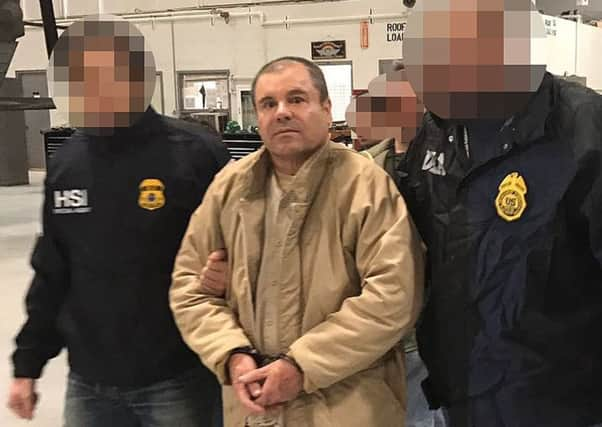Mexico’s most notorious drug lord El Chapo convicted by jury


The evidence was packed with Hollywood-style tales of grisly killings, political payoffs, cocaine hidden in jalapeno cans, jewel-encrusted guns and a naked escape with his mistress through a tunnel.
Guzman faced a drumbeat of drug-trafficking and conspiracy convictions that could put the 61-year-old escape artist behind bars for decades in a maximum-security US prison selected to thwart another of the breakouts that embarrassed his native country.
Advertisement
Hide AdAdvertisement
Hide AdNew York jurors whose identities were kept secret reached a verdict after deliberating for six days, sorting through what authorities called an “avalanche” of evidence gathered since the late 1980s that Guzman and his murderous Sinaloa drug cartel made billions in profits by smuggling tons of cocaine, heroin, meth and marijuana into the US.
Evidence showed drugs poured into the US through secret tunnels or hidden in tanker trucks and railway carriages passing through legitimate points of entry - suggesting a border wall would not be much of a worry.
The prosecution case against the diminutive Guzman, whose nickname translates to “Shorty”, included the evidence of several turncoats and other witnesses.
Among them were Guzman’s former Sinaloa lieutenants, a computer encryption expert and a Colombian cocaine supplier who underwent extreme plastic surgery to disguise his appearance.
One Sinaloa insider described Mexican workers getting contact highs while packing cocaine into thousands of jalapeno cans - shipments that totalled 25 to 30 tons of cocaine each year.
Another said Guzman sometimes acted as his own sicario, or hitman, punishing a Sinaloan who dared to work for another cartel by kidnapping him, beating and shooting him, and having his men bury the victim while he was still alive, gasping for air.
The defence case lasted just half an hour. Guzman’s lawyers did not deny his crimes as much as argue he was a fall guy for government witnesses who were more evil than he was.
Defence lawyer Jeffrey Lichtman urged the jury in closing arguments not to believe government witnesses who “lie, steal, cheat, deal drugs and kill people”.
Advertisement
Hide AdAdvertisement
Hide AdDeliberations were complicated by the trial’s vast scope. Jurors were tasked with making 53 decisions about whether prosecutors had proven different elements of the case.
The trial cast a harsh glare on the corruption that allowed the cartel to flourish. Colombian trafficker Alex Cifuentes caused a stir by testifying that former Mexican president Enrique Pena Nieto took a 100 million dollar bribe from Guzman.
Mr Pena Nieto denied it, but the allegation fit a theme: politicians, army commanders, police and prosecutors, all on the take. The tension at times was cut by some of the trial’s sideshows, such as the sight of Guzman and his wife, Emma Coronel Aispuro, showing up in matching burgundy velvet blazers in a gesture of solidarity.